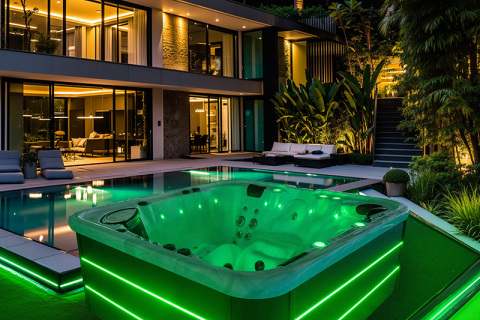
- Home
- >
News
When using an outdoor whirlpool hot tub, your body temperature is affected by the water temperature, dilating your skin's pores and accelerating blood circulation. If you don't rinse off immediately after leaving the tub, your body's temperature regulation system may be affected.
If the tub is designed for two people, the tub's size and massage jet distribution should be tailored to suit both. Too many jets can waste space, while too few can result in a poor massage effect. For a single-person tub, a smaller number of jets is usually sufficient, focusing on key areas of the body (such as the back, shoulders, and legs).
If the water in an outdoor whirlpool hot tub has a sour, musty, or rancid odor, it is often a sign of bacterial growth. When bacteria break down organic matter in the water, they release odorous chemicals, especially if the water is not cleaned and replaced promptly.
The combination of hot water and whirlpool massage in outdoor whirlpool hot tubs makes them uniquely effective in treating injuries, especially those related to muscles and joints. The effectiveness of outdoor whirlpool hot tubs varies depending on the injury.
Before purchasing, it's crucial to clearly define your needs for an outdoor whirlpool hot tub. For example, are you looking for pure relaxation or relief for a physical ailment? Do you plan to use it year-round, or only on special occasions? Only after clarifying your needs can you choose the right product.
For example, if a standard outdoor whirlpool hot tub has 10 jets, the pump power might be 1 kilowatt; if the number is increased to 20, the pump power requirement might increase to 1.5 kilowatts or more. This means that as the number of jets increases, the pump consumes more electricity to maintain normal operation.
The water pump and filter are responsible for maintaining the cleanliness and hygiene of your bathtub water, ensuring it remains free of contamination during use. Using soap or other detergents in your outdoor whirlpool hot tub can negatively impact the filtration system.
The heater is a crucial component of an outdoor whirlpool hot tub. The higher the heater power, the faster the water heats and the shorter the use time. However, a higher-power heater typically consumes more electricity, leading to higher electricity bills.
The hot water in a whirlpool hot tub causes the body to excrete large amounts of water through sweat. Prolonged soaking can lead to severe dehydration. Dehydration can cause a number of health problems, including dizziness, fatigue, and a rapid heartbeat.
If the showerheads of outdoor whirlpool hot tubs are not cleaned regularly, over time, dirt, grease, and other impurities can accumulate inside the showerheads. These contaminants can easily lead to clogging.
Many high-end outdoor whirlpool hot tubs utilize acrylic or acrylic for their exteriors. Acrylic offers excellent water resistance, effectively impermeable to water, and is also heat- and UV-resistant. This prevents moisture from the outside from penetrating into the tub.
Acrylic outdoor whirlpool hot tubs are frequently exposed to sunlight, and UV radiation is a major cause of fading. UV rays cause a chemical reaction on the acrylic surface, gradually breaking down the molecular structure of the material, resulting in color fading.












